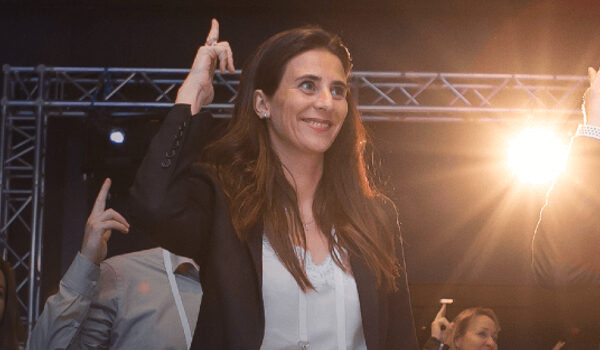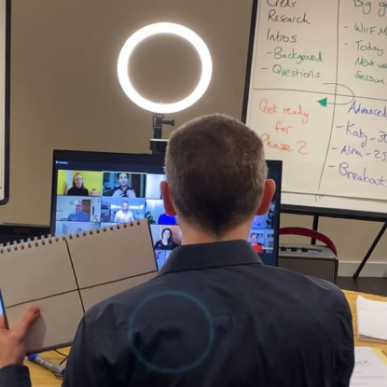At some point, you may need to give a presentation or pitch as part of a team. This creates huge challenges and many areas for you to beware of. You may have heard horror stories, such as…
- “We just decided who would talk about each slide in the taxi on the way to the meeting!”
- “We talked over each other and looked disorganised.”
- “Nobody knew where to stand or what to do when they weren’t speaking.”
It’s important to practice beforehand and make sure you have a plan. So here are a few simple tips that can make all the difference and help you engage your audience, reduce the pressure and help you work together effectively as a team, even if you have little time to prepare.
Strategic Positioning
People read time from left to right. No matter what culture you come from, a graph that displays time will have January on the left and December on the right. This means that the first person to talk should be on the audience’s left, and the next speaker should be on the audience’s right.
You will notice this in professional presenting teams. In the UK, “Ant and Dec” always stand so that Ant is on your left, and Dec is on the right (try Googling images of Ant and Dec, they are in the same position in every image!). In Casablanca, Humphrey Bogart is on the left in nearly every film shot, showing him as the lead character. A few years ago, the BBC had an issue of sexism raised because the male presenter was always put on the left of the screen – a position known in TV as ‘Presenter 1’. This means that if you want to lead the presentation and gain authority, that’s where you need to be.
Establishing Credibility with Content
Beyond strategic positioning, the substance of your presentation is also important. To build trust and engage your audience, ensure your content is top-notch. This means doing your homework and understanding your topic inside and out. It also means knowing your audience and being aware of what they want to hear. Scour their website and reflect on their business language in your presentation; Aristotle called this Ethos, establishing credibility by understanding their world. When your team collectively demonstrates expertise and a deep understanding of the subject matter and the audience, it reinforces your authority and persuasiveness.
Support Your Teammates
When you’re not speaking, watch the person who is! If you see a choir singing, you will instantly spot the one person scratching their head or looking out the window. As a co-presenter, you can make your team look better by watching them as they speak. It’s not about staring down the audience or the client; it’s about making your team shine. Don’t be tempted to check your smart devices in the background either; just because you’re not talking doesn’t mean the audience doesn’t have their eyes on you too! If you’re looking distracted or bored, this impacts the team.
Have you ever been in a situation where you could see your colleague struggling? If you sense the presenter has lost the thread or been put on the spot with a challenge, you can jump in and help them. Many presenters have an ‘anchor’ who supports them by being attentive, taking notes, and nodding whenever appropriate. This helps to make your team look more professional and polished. When we have multiple trainers in the room at Body Talk, we’ll raise our hand subtly if there is a difficult question or push back to show our colleagues we can help if they need us.
Seamless transitions
Handover using a name, not a nod. Take a look at Apple presentations – they have a team of people presenting, and they handover with the name of the person who is speaking next. This means the handover looks seamless, and there are no painful gaps or people talking over each other.
You can also use this technique in meetings. It’s all about ensuring everyone feels comfortable and knows when it is their turn to speak. This also helps to make the transitions smoother as there are no pauses whilst someone takes over – everyone has already been briefed about who is speaking next.
The Art of Timing
In addition to positioning, consider the timing of your presentation. Pacing is crucial for maintaining audience engagement. Avoid the dreaded scenario where your team members end up talking over each other, or one speaker dominates while others feel left out. To prevent this, allocate specific time slots for each speaker and topic. Use visual cues or digital timers to ensure everyone stays on track. This not only prevents chaos but also keeps the audience captivated throughout.
Masterful Body Language
Another essential aspect of an impressive team presentation is body language. Non-verbal cues can convey confidence, collaboration, and professionalism. Encourage your team to maintain open and welcoming postures, make eye contact with the audience, and use gestures to emphasise key points. It’s not just about what you say; it’s also about how you say it.
Post-Presentation Feedback
Once the presentation is over, don’t neglect the importance of feedback. Conduct a debrief with your team to discuss what went well and what could be improved. Honest feedback helps refine your team’s performance for future presentations. Additionally, reach out to the audience or client for their insights. This demonstrates your commitment to continuous improvement and strengthens your professional relationships.





















